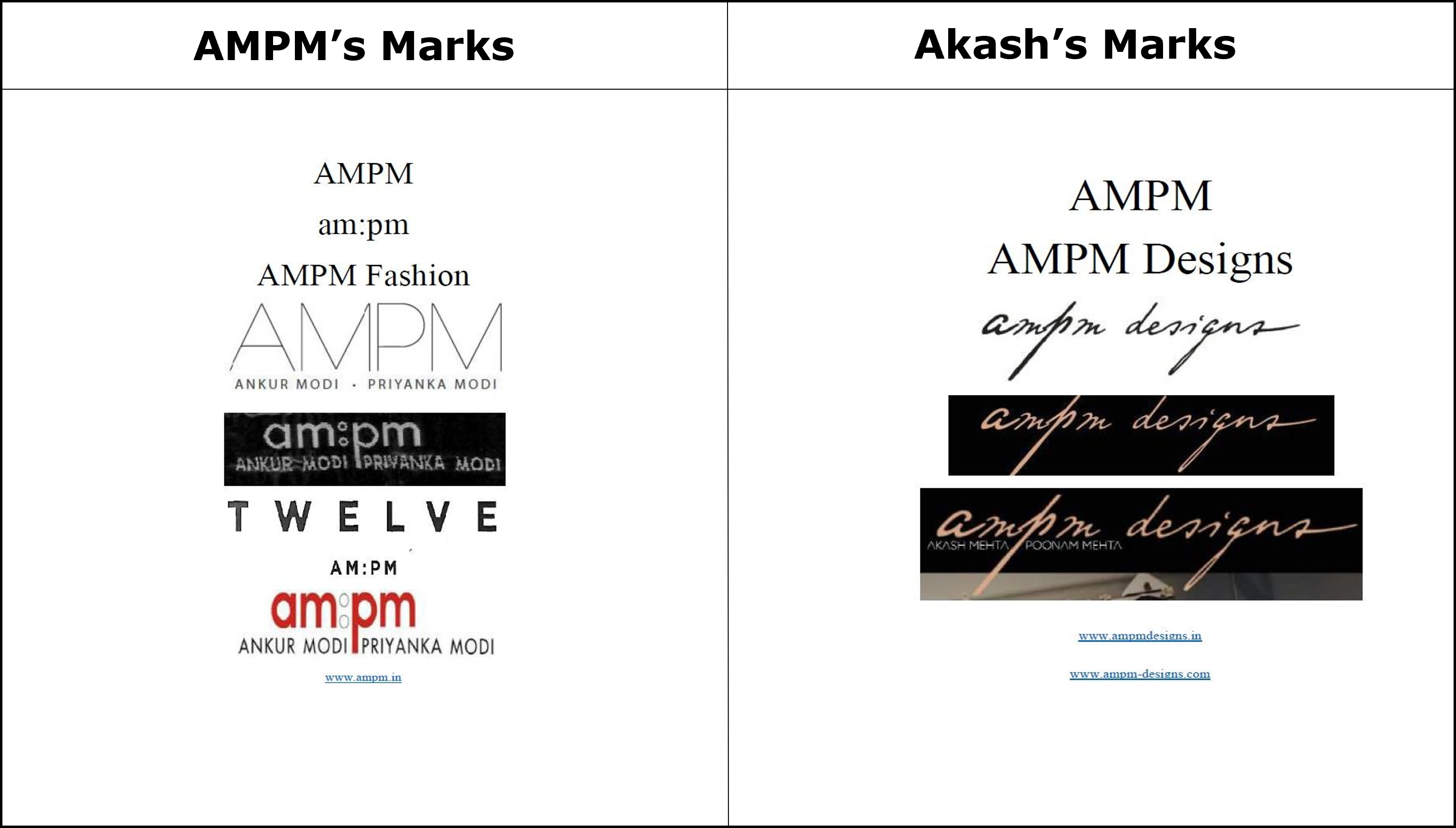AMPM mark falls short of being a well-known mark
The parties in this case AMPM Fashions Pvt. Ltd, the Plaintiff (AMPM ) and Akash Anil Mehta and others, the Defendants (Akash) are locked in a battle, concerning the use of the trademark ‘AMPM’. The rival trademarks are set out below:

AMPM Fashions Pvt Ltd, the Plaintiff (AMPM) filed the action before the Delhi High Court to restrain the Defendants, Akash Anil Mehta and others., (Akash) from using the mark AMPM in relation to their business. The injunction application filed by AMPM is being considered by the Court.
AMPM in the suit contended:
- The mark AMPM is the shortened form of the names of the owners, Ankur Modi and Priyanka Modi. They are engaged in the business of fashion designing and deal in a range of products, not limited to, wearable goods such as churidars, kurtas, women’s shirts, including footwear, belts, and other accessories.
- The AMPM word and device mark are registered in Classes 18, 23, 24, 25, and 26 and the earliest registration date back to the year 2009 with use since 2002. Their application is pending registration in class 42.
- ‘AMPM’ is a well-known mark and they have spent a substantial amount to promote the brand.
- AMPM is contained in its entirety in Akash’s mark and the word ‘designs’ is an insignificant addition and ought to be ignored.
- The Intellectual Property Appellate Board has ordered the removal of Akash’s registration for the mark ‘ampm designs’ in Class 42.
- The two businesses are allied and cognate as it is natural to progress from fashion designing to interior designing.
Akash countered the injunction application on the following grounds:
- AMPM is an acronym for the names of its owners, i.e., Akash Anil Mehta and Poonam Mehta. They are engaged in the business of interior design and lighting solutions.
- The mark is registered in Class 42, and they render services and do not deal in goods. The customers of both parties are discerning and highly educated. Furthermore, the trade channels and target customers differ.
- The rival marks are visually different. Akash uses the word ‘designs’ with their mark and AMPM admittedly does not deal with interior designs.
- AM and PM are generic words that cannot be appropriated by one person or entity. Several third parties are using the trademark AMPM as their trademark and are also registered in different classes.
- Several companies are also registered with the Registrar of companies with AMPM as part of their trading name
Court’s findings
- Admittedly, AMPM is dealing in high-fashion clothing and wearable accessories, whereas, Akash is in the business of interior design and lighting solutions. Even though AMPM claims use of the mark since 2002, documents on record show use of the mark only from 2006. AMPM deals in goods, which are bought off the shelf or sold through e-commerce platforms, whereas, Akash is in the business of providing services, which are personal and customized.
- AMPM does not have registration in class 42 that covers ‘interior designing and lighting solutions’. Akash had challenged the IPAB order rectifying their mark in class 42. The operation of the IPAB order was stayed by the Bombay High Court. Therefore, the registration of Akash is valid as of now.
- Likelihood of confusion would arise if there is a risk of the relevant consumers/public believing that the goods or services offered by one originates from the other or in some way economically linked to the other. AMPM has not placed on record any material to show confusion in the market. Further, the chances of the customers being confused regarding Akash’s services seems remote, at this point.
- AMPM has also not placed anything on record to establish that it has the necessary goodwill/reputation in relation to interior design and lighting solutions. Thus, merely because they are a prior user of the mark will not entitle them to restrain Akash from using the mark in relation to their business. The absence of a common field of activity is a significant and relevant consideration in deciding whether there is a likelihood of confusion.
- In the instant case, it is evident that AMPM has failed to meet the threshold prescribed for a well-known mark. The promotional materials and the advertising spent is not so expansive to conclude, at this stage, that AMPM is a well-known mark. Further to restrain, AMPM has failed to show that the use of the impugned mark for interior design and lighting solutions by Akash is likely to result in damages on account of misrepresentation concerning the origin of services.
- Akash also filed an affidavit stating that they will add the subtitle “Interior design by Akash Mehta and Poonam Mehta” to the impugned mark.
Given the above, the court refused to grant an injunction in favour of AMPM to restraint use of the mark.
Please follow and like us:



